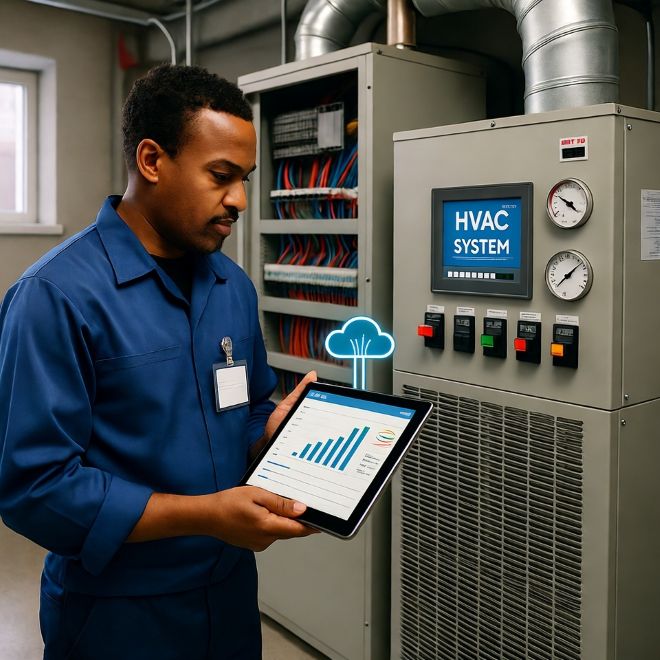
Smart devices are changing the way people manage their homes. Connected living has redefined comfort and energy efficiency, especially when it comes to heating and cooling. Modern HVAC systems go beyond basic temperature control, working with apps, voice assistants, and cloud platforms to anticipate needs and deliver precise comfort tailored to each household.
For homeowners exploring upgrades or even heat pump repair, integrating smart home technology offers a clear advantage. From learning thermostats that adapt to your routine to AI-driven alerts that prevent costly breakdowns, today’s systems redefine how comfort and convenience blend in modern living spaces.
Smart Sensors for Temperature Precision
Smart sensors are the quiet heroes behind the modern HVAC revolution. They read temperature, humidity, and air quality in real time, adjusting your system automatically for maximum comfort. Instead of relying on a single thermostat in one room, distributed sensors help maintain even temperatures throughout your home. They also reduce energy waste, ensuring you only heat or cool the spaces that need it most.
According to studies from energy research groups, using smart sensors can lower HVAC energy consumption by up to 20%. This not only improves comfort but also supports sustainability goals by reducing a home’s carbon footprint. When paired with mobile apps, homeowners can view room-by-room data, tweak settings remotely, and track energy performance with ease.
AI-Assisted Predictive Maintenance Apps
Artificial intelligence is changing how technicians and homeowners think about HVAC maintenance. Predictive apps now monitor system performance 24/7, learning from data trends to detect problems before they escalate. Whether it is a clogged filter or a refrigerant leak, these systems alert users instantly, helping prevent downtime and expensive repairs.
For example, AI platforms can analyze airflow and compressor behavior to identify inefficiencies that humans might miss. This approach saves time and keeps systems running smoothly. It is particularly valuable for homeowners who have invested in new smart systems and want to maximize longevity while keeping maintenance hassle-free.
Integrating HVAC with Alexa and Google Home
Voice control has become one of the most convenient features in smart homes. Linking your HVAC system to Alexa or Google Home allows you to adjust temperatures using simple commands like, “Alexa, set the living room to 72 degrees.” The integration also lets you create routines, such as lowering the temperature automatically when you say, “Good night.”
These integrations make HVAC control accessible to everyone, including those who prefer hands-free operation. Plus, they work well with other smart devices. Imagine your blinds closing, your lights dimming, and your HVAC switching to eco mode—all triggered by one phrase. It is an effortless blend of comfort and energy efficiency that aligns with the way people actually live.
Cloud-Based Monitoring for Technicians and Homeowners
Cloud technology is making HVAC systems smarter and more connected than ever. Both homeowners and service providers benefit from real-time data access through cloud dashboards. For technicians, this means remote diagnostics, system performance analysis, and instant alerts when something goes wrong. For homeowners, it translates to greater transparency and faster service.
Cloud monitoring is especially useful during seasonal changes when systems work hardest. Homeowners can check efficiency metrics, filter status, and overall health from their smartphones. Some providers even use this data to automate service scheduling, ensuring preventive maintenance happens before problems arise. This proactive model is transforming how HVAC companies build trust and efficiency into their operations.
Unified Apps for Whole-Home Integration
The future of HVAC management lies in unified control. Many modern homes now use centralized apps that combine lighting, security, entertainment, and HVAC control into one interface. These platforms use machine learning to understand daily routines, adjusting temperature and airflow patterns to balance comfort and cost. For instance, the system might cool the house just before you return from work or switch to energy-saving mode when it detects you are away.
This holistic approach also allows for better data analysis. Homeowners can view patterns, track energy use, and make informed adjustments. The more connected devices you add, the smarter your home becomes, creating a seamless experience that saves both time and money.
Explore what makes the best smart home system work seamlessly to connect your devices and elevate your HVAC control experience. Read this guide: The Best Smart Home System: Do You Need One?
Conclusion: The Smart Future of Home Comfort
Technology has turned HVAC systems into intelligent partners in home management. Whether through AI diagnostics, smart sensors, or integration with voice assistants, every upgrade contributes to a home that thinks ahead. For homeowners scheduling upgrades or heat pump repair, these innovations offer more than convenience. They deliver long-term savings, improved comfort, and a smaller environmental impact.
As the Internet of Things continues to evolve, smart HVAC integration will become standard rather than luxury. The result is a home that breathes with you, adapting, learning, and optimizing for the perfect balance of comfort and efficiency.
